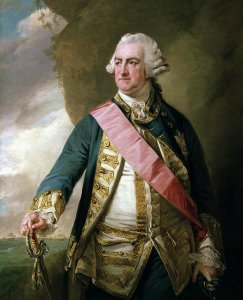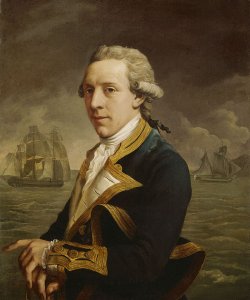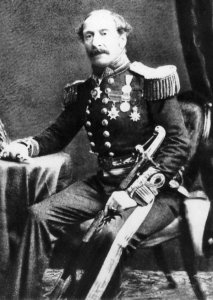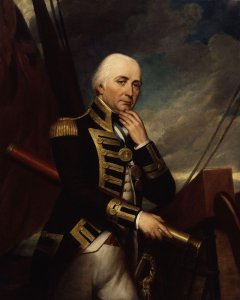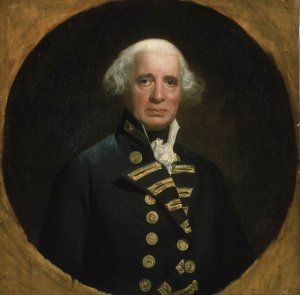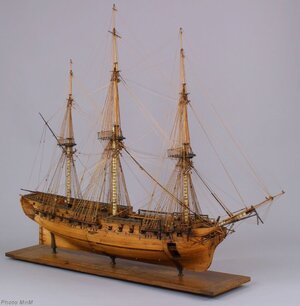Today in Naval History - Naval / Maritime Events in History
19th of February
please use the following link and you will find the details and all events of this day ..... in the following you will find some of the events
1694 - HMS Sussex (80), Ad. Sir Francis Wheler, and HMS Cambridge (70) Capt. John WARD, lost in a hurricane off Gibraltar - in total 13 ships were lost with 1,200 casualties in total
HMS Sussex was an 80-gun third-rate ship of the line of the English Royal Navy, lost in a severe storm on 19 February 1694 off Gibraltar. On board were possibly 10 tons of gold coins. This could now be worth more than $500 million, including the bullion and antiquity values, making it one of the most valuable wrecks ever.

Model of HMS Sussex, starboard
A wonderful model of the Sussex in scale 1:60 was built by our member @ramonolivenza I was able to see in reality during my visit in Rochefort last year:

1741 – Launch of HMS Drake, an 8-gun snow-rigged sloop of the Royal Navy,
HMS Drake was an 8-gun snow-rigged sloop of the Royal Navy, launched in 1741 as the first of three Drake class sloops constructed for convoy duty during the Anglo-Spanish War of Jenkins' Ear from 1739 to 1742. After limited service off the Channel Islands, she was sailed to Gibraltar where she was wrecked in 1742 while under the temporary command of her first lieutenant.

1758 - HMS Invincible (74) lost on the Owers.
The Invincible was originally a 74-gun ship of the line of the French Navy launched in October 1744. Captured on 14 October 1747, she was taken into Royal Navy service as the third rate HMS Invincible.

1760 - Launch of HMS Bellona, a 74-gun Bellona-class third-rate ship of the line of the Royal Navy
HMS Bellona was a 74-gun Bellona-class third-rate ship of the line of the Royal Navy. Designed by Sir Thomas Slade, she was a prototype for the iconic 74-gun ships of the latter part of the 18th century. "The design of the Bellona class was never repeated precisely, but Slade experimented slightly with the lines, and the Arrogant, Ramillies, Egmont, and Elizabeth classes were almost identical in size, layout, and structure, and had only slight variations in the shape of the underwater hull. The Culloden class ship of the line was also similar, but slightly larger. Thus over forty ships were near-sisters of the Bellona." Bellona was built at Chatham, starting on 10 May 1758, launched on 19 February 1760, and commissioned three days later. She was the second ship of the Royal Navy to bear the name, and saw service in the Seven Years' War, American Revolutionary War and the Napoleonic Wars.

1794 - British squadron under Commodore Robert Linzee captured Minerve.
Minerve was a 40-gun frigate of the French Navy, lead ship of her class. She operated in the Mediterranean during the French Revolutionary Wars. Her crew scuttled her at Saint-Florent to avoid capture when the British invaded Corsica in 1794, but the British managed to raise her and recommissioned her in the Royal Navy as the 38-gun fifth rate HMS St Fiorenzo (also San Fiorenzo).

1801 - Action of 19 February 1801
HMS Phoebe (36), Cptn. Robert Barlow took French frigate Africaine (44), Cptn. Majendie, off Ceuta in Morocco.
The Action of 19 February 1801 was a minor naval battle fought off Ceuta in Spanish North Africa in February 1801 between frigates of the French and Royal Navies during the French Revolutionary Wars. The engagement formed part of a series of actions fought to prevent the French from resupplying their garrison in Egypt, which had been trapped there without significant reinforcement since the defeat of the French Mediterranean Fleet at the Battle of the Nile two and a half years earlier. The leader of the Egyptian expedition, General Napoleon Bonaparte, had returned to France in 1799 and promised aid to the troops left behind, prompting several expeditions to the region carrying reinforcements.
The frigate Africaine had been sent from Rochefort early in 1801 with more than 400 soldiers for the Egyptian garrison, and by February had reached the Mediterranean Sea, Commodore Saulnier seeking to pass along the North African coast to avoid patrolling Royal Navy warships. On the afternoon of 19 February however the overladen French warship was discovered by the British HMS Phoebe and rapidly chased down and brought to action. In an engagement lasting two hours, the French ship was reduced to a wallowing wreck as broadsides from Phoebe tore through the hull, rigging and the soldiers packed on the decks: by the time Africaine surrendered, 200 men were dead and another 143 wounded. The captured ship was brought into the base at Port Mahon in Menorca and subsequently served in the Royal Navy.

1804 - Gun-brig HMS Cerbere, Lt. Joseph Patey, wrecked on rocks near Berry Head, Torbey
HMS Cerbere was the French naval brig Cerbère, ex-Chalier, which the British captured in 1800. She was wrecked in 1804.

1829 – Launch of HMS Eurotas, a Seringapatam-class frigate
The Seringapatam-class frigates, were a class of British Royal Navy 46-gun sailing frigates. The first vessel of the class was HMS Seringapatam. Seringapatam's design was based on the French frigate Président, which the British had captured in 1806. Seringapatam was originally ordered as a 38-gun frigate, but the re-classification of British warships which took effect in February 1817 raised this rating to 46-gun.


1860 - transatlantic steamship of the Canadian Allan Line SS Hungarian was wrecked at Cape Sable Island, off Nova Scotia, with the loss of all aboard.
SS Hungarian was a transatlantic steamship of the Canadian Allan Line that was launched in 1858, completed in 1859 and sank in 1860.
William Denny and Brothers of Dumbarton, Scotland launched her on September 25, 1858. She was powered by a 400 nhp direct-acting steam engine that drove a single screw. She was completed in 1859. Hungarian's maiden voyage began on May 18, 1859 when she left Liverpool for Quebec. She was wrecked in 1860 at Cape Sable Island, off Nova Scotia, with the loss of all aboard.

Vectorized picture of steamer Hungarian
1901 – Launch of HMS Russell, a Duncan-class pre-dreadnought battleship of the Royal Navy
HMS Russell was a Duncan-class pre-dreadnought battleship of the Royal Navy commissioned in 1903. Built to counter a group of fast Russian battleships, Russell and her sister ships were capable of steaming at 19 knots (35 km/h; 22 mph), making them the fastest battleships in the world. The Duncan-class battleships were armed with a main battery of four 12-inch (305 mm) guns and they were broadly similar to the London-class battleships, though of a slightly reduced displacement and thinner armour layout. As such, they reflected a development of the lighter second-class ships of the Canopus-class battleship. Russell was built between her keel laying in March 1899 and her completion in February 1903.

1915 – World War I: The first naval attack on the Dardanelles begins when a strong Anglo-French task force bombards Ottoman artillery along the coast of Gallipoli.
The Naval Operations in the Dardanelles Campaign (17 February 1915 – 9 January 1916) took place against the Ottoman Empire during the First World War. Ships of the Royal Navy, French Marine nationale, Imperial Russian Navy (Российский императорский флот) and the Royal Australian Navy, attempted to force the defences of the Dardanelles Straits. The straits are a narrow waterway connecting the Mediterranean Sea with the Black Sea, via the Aegean, Sea of Marmara and the Bosphorus. The Dardanelles Campaign began as a naval operation but the success of the Ottoman defence led to the Gallipoli Campaign, an attempt to occupy the Gallipoli peninsula with land forces supported by the navies, to open the sea route to Constantinople. The Allies also tried to pass submarines through the Dardanelles to attack Ottoman shipping in the Sea of Marmara.

1929 - TSS Kanowna, an Australian steamer built during 1902, ran aground and sank
TSS Kanowna, was an Australian steamer built during 1902. The 6,993-ton, 126-metre (413 ft)[citation needed] long Kanowna was constructed by William Denny and Brothers of Dumbarton, Scotland, and had a twin screw design

1942 - The Japanese attack Darwin, Australia in the largest attack by a foreign power on that country.
USS Peary (DD 226), as well as an Army transport and freighter sink in the raid, as well as a number of Australian and British vessels.
The Bombing of Darwin, also known as the Battle of Darwin, on 19 February 1942 was the largest single attack ever mounted by a foreign power on Australia. On that day, 242 Japanese aircraft, in two separate raids, attacked the town, ships in Darwin's harbour and the town's two airfields in an attempt to prevent the Allies from using them as bases to contest the invasion of Timor and Java during World War II.
Darwin was lightly defended relative to the size of the attack, and the Japanese inflicted heavy losses upon Allied forces at little cost to themselves. The urban areas of Darwin also suffered some damage from the raids and there were a number of civilian casualties. More than half of Darwin's civilian population left the area permanently, before or immediately after the attack.
The two Japanese air raids were the first, and largest, of more than 100 air raids against Australia during 1942–43.

1942 – French Surcouf, the largest French cruiser submarine, disappeared
Surcouf was the largest French cruiser submarine. She served in both the French Navy and the Free French Naval Forces during the Second World War. She was lost during the night of 18/19 February 1942 in the Caribbean Sea, possibly after colliding with an American freighter. Surcouf was named after the French privateer Robert Surcouf. She was the largest submarine built until surpassed by the first Japanese I-400-class submarine in 1943.


19th of February
please use the following link and you will find the details and all events of this day ..... in the following you will find some of the events
Naval/Maritime History - 27th of August - Today in Naval History - Naval / Maritime Events in History
Today in Naval History - Naval / Maritime Events in History 18 February 1800 - The Battle of the Malta Convoy HMS Alexander (74), Lt. William Harrington (Acting), and HMS Success (32), Cptn. Shuldham Peard, captured Genereux (74) off Malta. Généreux was a French Téméraire-class 74-gun ship...
shipsofscale.com
1694 - HMS Sussex (80), Ad. Sir Francis Wheler, and HMS Cambridge (70) Capt. John WARD, lost in a hurricane off Gibraltar - in total 13 ships were lost with 1,200 casualties in total
HMS Sussex was an 80-gun third-rate ship of the line of the English Royal Navy, lost in a severe storm on 19 February 1694 off Gibraltar. On board were possibly 10 tons of gold coins. This could now be worth more than $500 million, including the bullion and antiquity values, making it one of the most valuable wrecks ever.
Model of HMS Sussex, starboard
A wonderful model of the Sussex in scale 1:60 was built by our member @ramonolivenza I was able to see in reality during my visit in Rochefort last year:
1741 – Launch of HMS Drake, an 8-gun snow-rigged sloop of the Royal Navy,
HMS Drake was an 8-gun snow-rigged sloop of the Royal Navy, launched in 1741 as the first of three Drake class sloops constructed for convoy duty during the Anglo-Spanish War of Jenkins' Ear from 1739 to 1742. After limited service off the Channel Islands, she was sailed to Gibraltar where she was wrecked in 1742 while under the temporary command of her first lieutenant.
1758 - HMS Invincible (74) lost on the Owers.
The Invincible was originally a 74-gun ship of the line of the French Navy launched in October 1744. Captured on 14 October 1747, she was taken into Royal Navy service as the third rate HMS Invincible.
1760 - Launch of HMS Bellona, a 74-gun Bellona-class third-rate ship of the line of the Royal Navy
HMS Bellona was a 74-gun Bellona-class third-rate ship of the line of the Royal Navy. Designed by Sir Thomas Slade, she was a prototype for the iconic 74-gun ships of the latter part of the 18th century. "The design of the Bellona class was never repeated precisely, but Slade experimented slightly with the lines, and the Arrogant, Ramillies, Egmont, and Elizabeth classes were almost identical in size, layout, and structure, and had only slight variations in the shape of the underwater hull. The Culloden class ship of the line was also similar, but slightly larger. Thus over forty ships were near-sisters of the Bellona." Bellona was built at Chatham, starting on 10 May 1758, launched on 19 February 1760, and commissioned three days later. She was the second ship of the Royal Navy to bear the name, and saw service in the Seven Years' War, American Revolutionary War and the Napoleonic Wars.
1794 - British squadron under Commodore Robert Linzee captured Minerve.
Minerve was a 40-gun frigate of the French Navy, lead ship of her class. She operated in the Mediterranean during the French Revolutionary Wars. Her crew scuttled her at Saint-Florent to avoid capture when the British invaded Corsica in 1794, but the British managed to raise her and recommissioned her in the Royal Navy as the 38-gun fifth rate HMS St Fiorenzo (also San Fiorenzo).
1801 - Action of 19 February 1801
HMS Phoebe (36), Cptn. Robert Barlow took French frigate Africaine (44), Cptn. Majendie, off Ceuta in Morocco.
The Action of 19 February 1801 was a minor naval battle fought off Ceuta in Spanish North Africa in February 1801 between frigates of the French and Royal Navies during the French Revolutionary Wars. The engagement formed part of a series of actions fought to prevent the French from resupplying their garrison in Egypt, which had been trapped there without significant reinforcement since the defeat of the French Mediterranean Fleet at the Battle of the Nile two and a half years earlier. The leader of the Egyptian expedition, General Napoleon Bonaparte, had returned to France in 1799 and promised aid to the troops left behind, prompting several expeditions to the region carrying reinforcements.
The frigate Africaine had been sent from Rochefort early in 1801 with more than 400 soldiers for the Egyptian garrison, and by February had reached the Mediterranean Sea, Commodore Saulnier seeking to pass along the North African coast to avoid patrolling Royal Navy warships. On the afternoon of 19 February however the overladen French warship was discovered by the British HMS Phoebe and rapidly chased down and brought to action. In an engagement lasting two hours, the French ship was reduced to a wallowing wreck as broadsides from Phoebe tore through the hull, rigging and the soldiers packed on the decks: by the time Africaine surrendered, 200 men were dead and another 143 wounded. The captured ship was brought into the base at Port Mahon in Menorca and subsequently served in the Royal Navy.
1804 - Gun-brig HMS Cerbere, Lt. Joseph Patey, wrecked on rocks near Berry Head, Torbey
HMS Cerbere was the French naval brig Cerbère, ex-Chalier, which the British captured in 1800. She was wrecked in 1804.
1829 – Launch of HMS Eurotas, a Seringapatam-class frigate
The Seringapatam-class frigates, were a class of British Royal Navy 46-gun sailing frigates. The first vessel of the class was HMS Seringapatam. Seringapatam's design was based on the French frigate Président, which the British had captured in 1806. Seringapatam was originally ordered as a 38-gun frigate, but the re-classification of British warships which took effect in February 1817 raised this rating to 46-gun.
1860 - transatlantic steamship of the Canadian Allan Line SS Hungarian was wrecked at Cape Sable Island, off Nova Scotia, with the loss of all aboard.
SS Hungarian was a transatlantic steamship of the Canadian Allan Line that was launched in 1858, completed in 1859 and sank in 1860.
William Denny and Brothers of Dumbarton, Scotland launched her on September 25, 1858. She was powered by a 400 nhp direct-acting steam engine that drove a single screw. She was completed in 1859. Hungarian's maiden voyage began on May 18, 1859 when she left Liverpool for Quebec. She was wrecked in 1860 at Cape Sable Island, off Nova Scotia, with the loss of all aboard.
Vectorized picture of steamer Hungarian
1901 – Launch of HMS Russell, a Duncan-class pre-dreadnought battleship of the Royal Navy
HMS Russell was a Duncan-class pre-dreadnought battleship of the Royal Navy commissioned in 1903. Built to counter a group of fast Russian battleships, Russell and her sister ships were capable of steaming at 19 knots (35 km/h; 22 mph), making them the fastest battleships in the world. The Duncan-class battleships were armed with a main battery of four 12-inch (305 mm) guns and they were broadly similar to the London-class battleships, though of a slightly reduced displacement and thinner armour layout. As such, they reflected a development of the lighter second-class ships of the Canopus-class battleship. Russell was built between her keel laying in March 1899 and her completion in February 1903.
1915 – World War I: The first naval attack on the Dardanelles begins when a strong Anglo-French task force bombards Ottoman artillery along the coast of Gallipoli.
The Naval Operations in the Dardanelles Campaign (17 February 1915 – 9 January 1916) took place against the Ottoman Empire during the First World War. Ships of the Royal Navy, French Marine nationale, Imperial Russian Navy (Российский императорский флот) and the Royal Australian Navy, attempted to force the defences of the Dardanelles Straits. The straits are a narrow waterway connecting the Mediterranean Sea with the Black Sea, via the Aegean, Sea of Marmara and the Bosphorus. The Dardanelles Campaign began as a naval operation but the success of the Ottoman defence led to the Gallipoli Campaign, an attempt to occupy the Gallipoli peninsula with land forces supported by the navies, to open the sea route to Constantinople. The Allies also tried to pass submarines through the Dardanelles to attack Ottoman shipping in the Sea of Marmara.
1929 - TSS Kanowna, an Australian steamer built during 1902, ran aground and sank
TSS Kanowna, was an Australian steamer built during 1902. The 6,993-ton, 126-metre (413 ft)[citation needed] long Kanowna was constructed by William Denny and Brothers of Dumbarton, Scotland, and had a twin screw design
1942 - The Japanese attack Darwin, Australia in the largest attack by a foreign power on that country.
USS Peary (DD 226), as well as an Army transport and freighter sink in the raid, as well as a number of Australian and British vessels.
The Bombing of Darwin, also known as the Battle of Darwin, on 19 February 1942 was the largest single attack ever mounted by a foreign power on Australia. On that day, 242 Japanese aircraft, in two separate raids, attacked the town, ships in Darwin's harbour and the town's two airfields in an attempt to prevent the Allies from using them as bases to contest the invasion of Timor and Java during World War II.
Darwin was lightly defended relative to the size of the attack, and the Japanese inflicted heavy losses upon Allied forces at little cost to themselves. The urban areas of Darwin also suffered some damage from the raids and there were a number of civilian casualties. More than half of Darwin's civilian population left the area permanently, before or immediately after the attack.
The two Japanese air raids were the first, and largest, of more than 100 air raids against Australia during 1942–43.
1942 – French Surcouf, the largest French cruiser submarine, disappeared
Surcouf was the largest French cruiser submarine. She served in both the French Navy and the Free French Naval Forces during the Second World War. She was lost during the night of 18/19 February 1942 in the Caribbean Sea, possibly after colliding with an American freighter. Surcouf was named after the French privateer Robert Surcouf. She was the largest submarine built until surpassed by the first Japanese I-400-class submarine in 1943.






